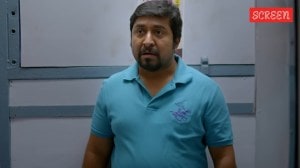The Skull Beneath the Skin
For not having loved ones dead father enough,could one make amends by loving ones child more?
Way to Go
Upamanyu Chatterjee
Hamish Hamilton
Pages: 359
Rs 499
For not having loved ones dead father enough,could one make amends by loving ones child more? That idea an indecisive moth that fluttered out of the blue walls of the police station and circled the head of his mustached interlocutor took time to form,glass-like,in Jamuns head,much as though it had been biding its time to be recognised,like a scene patiently awaiting a correctly focused lens.
These are the headlong sentences of Upamanyu Chatterjees new novel Way to Go. They are typical of the indiscriminate,often comical piling of description that you can either hate or tolerate about his style.
This novel brings back a familiar set of people,Jamun,Burfi and Shyamanand,from his second book The Last Burden and the loathing sort of love that they specialise in. After years of living together,Jamun is stricken with guilt and panic as his 85-year-old father Shyamanand goes missing one day. Burfi,his estranged brother,is dealing with his own desolations. Meanwhile,the value of their family home has appreciated substantially,and is being eyed by an unethical,social-climbing builder. There is also a dramatic death,and its discovery.
Jamuns former girlfriend Kasturi (she of the coffee-with-milk skin) now makes a TV melodrama called Cheers,Zindagi,where she processes the pain and weirdness of their lives into wildly popular entertainment,and where Jamun shows up as a nostril-flaring guy called Ashwamedha Ponytail. Black and scarred souls are major draws both in life and on television, says Kasturi with great authority.
Hmm. I dont know. But its clear she has some authorial backing here,given Chatterjees tendency to serve up the same curdled characters. Way to Go still has the same disaffected,dirty-minded narrative voice no matter whose interior life it focuses on. From the most unpleasant possible examination of ageing,disease,copulation,excretion,flatulence and effluvia to loveless families,sordid relationships and class exploitation,nothing human is alien to this novel. Except the good bits.
There are many distended passages where Jamun or Burfi watch,in mesmerised slo-mo,as some petty authority figure licks his finger or massages a books spine with meaty,snake-like fingers or displays swamp-like sweat patches. There are pages and pages of a postmortem: His stomach began to writhe only when Rathnam pushed his red hands into the corpses abdominal cavity and groped about,inexorably,slowly,churned the crimson mire of the intestines.
Which is not to say that Way to Go is not worth reading,if you have the stomach for it. It is sneakily,genuinely funny in moments. It tells an action-packed story. It teases some filaments of sincere feeling,like Burfis helpless memory of his mothers death,the tense way that he stands watch over his fathers bedside. Whether or not it examines the redemptive power of love,as the jacket claims,it can sometimes move you in spite of yourself,and in spite of the stunted,shiftless characters.





- 01
- 02
- 03
- 04
- 05


























